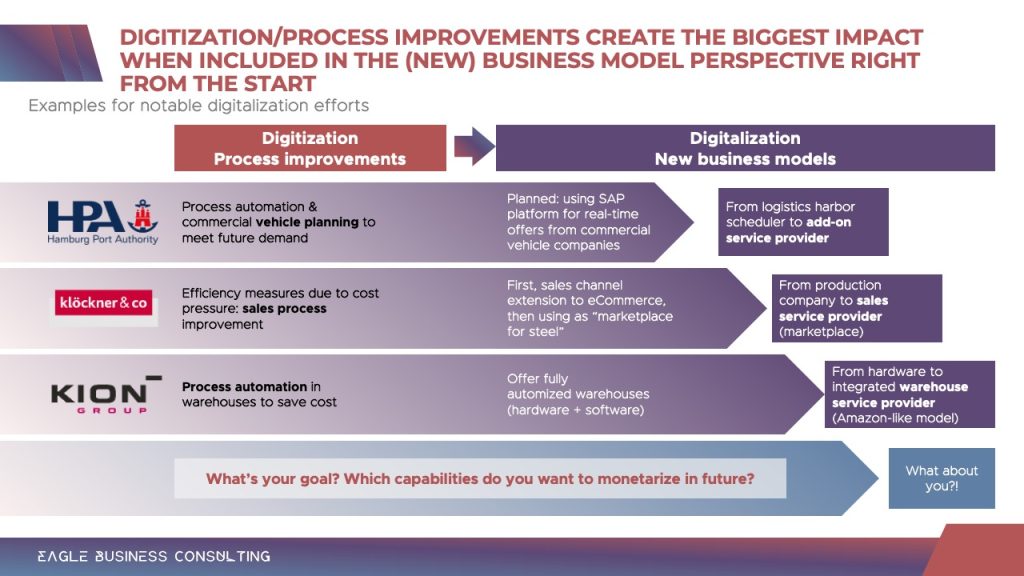Sure, digitalization is not only seen as “just going paperless” but far too often businesses — regardless whether small or large — mistakenly think digitalization is only an effort around becoming more efficient and improving their IT solutions.
However, the real deal of digitalization lies in the upside of digitalization. Usually, more than 60% of digitalization advantages come from these upside efforts which focus on expanding, re-inventing, and disrupting the business model to become more important to existing and new customers. Many companies realized this potential often along the way of digitization and by almost accidently inventing new business models.
Before we jump into three examples of companies which started with digitization and ended with new digital business models, let’s have a short look at the general definition of digitalization:
“The use of digital technologies to change a business model and provide new revenue and value-producing opportunities. It is the process of moving to a digital business.” Gartner glossary

Digitisation efforts normally focus on the internal effects, as well as intersections with customers, helping companies to become more efficient, effective, transparent, and reduce costs as well as liberate their staff from mundane tasks for other value-creation activities. Often cost-savings effects of efficiency strategies are comparatively negligible in the short- to medium-term and larger benefits often require a high upfront investment as well as an overhaul of the company’s key processes and IT.
The upside of digitalisation is to focus on external effects: the creation of new revenue streams, often through new, service-based business models. Companies not only create a new income stream and higher revenues but also become more relevant to the market as they offer products & services which market needs to digitalize itself. Digitalization often attracts totally new customers groups – and in best case these new products & services reshape or disrupt the market.
Both effects drive companies – and their employees – to keep up with the technological evolution and with the evolution of their customers’ needs. It nudges companies to strengthen their core capabilities and to build up entirely new and digital capabilities.
As many companies still start with digitisation and end up with digitalization, we look now at a selection of success stories which fit into that scheme.

What is needed for a digitalization strategy?
From my experience, usually mid- to large-size companies focus on:
- Formulating a compelling and convincing vision, supported by a strategic growth plan
- Taking large, evolutionary steps forward into the unknown
- Selecting a motivated, skilled, and open-minded team who want to make it happen
- Defining proper budget to establish new digital capabilities and to think disruptively
In short: Vision, hunger, grit, and $.
The one who will walk in this direction knows that digitalization, in particular disruption, is painful, as change is one of the greatest fears of us human beings. However, for some select people it’s simultaneously exciting and particularly rewarding – as it is for the company itself. Hence, finding your rockstar change-makers will be key. These people need to be not only willing to drive change; but to create change, as they are tapping into the realm of the unknown, which hosts infinite new opportunities. Don’t let your change-makers continually burn their candles at both ends; focus on waves of productivity, followed by waves of recovery, as change is often a marathon and not a sprint (in particular, for large corporations).
Keep your eye more on the vision than on the exact plan; The direction in which to sail should be clear, and sufficient flexibility should be granted to adapt, when needed, to feedback from the market/customers and for new ideas.
Don’t get fixated on a particular product/service idea, rather focus on having a grip on change itself instead of very concrete specifics of a product early on. Talk to your customers and get feedback early on, as early as possible. Ultimately, it’s their product/service, not yours.
Have fun. Yes, you read correctly. Have fun! (A ‘side effect’ of having fun is higher productivity, hence, as a leader, it is your business to ensure that your people have fun at work. A lot.)
But what prevents companies, bosses, and managers from pursuing digitalization?
I haven’t performed an exhaustive survey (not yet at least), but I’m sure time, money, skills and ‘we have done it always like that’ will be very popular as reasons keeping companies from moving forward.
But even when these initial elements are resolved – often when the market pressure get very uncomfortable (in fact, the biggest motivator for change is pain) – digitalization still has its hurdles to come to full fruition, as change is (still) painful for human beings, including the leadership team as I come to understand during many discussions. I had to realize that change is not only very uncomfortable but actively avoided. The higher I talked up the ladder, the more often I would be stopped, with either a straight “No, we don’t do that” or the evasion, “It’s the corporate’s responsibility, so we don’t do that”. However, it’s no wonder as the change-maker team is being the selected to be change-makers (often e.g., ENTJs, ENTPs) but their bosses are their leaders due to other capabilities, primarily that they are excellent at keeping the system efficiently running (often e.g., ESTJs, ISTJs). This dynamic often leads to frustration within the change-maker team as they seek either help from their leadership peers to design the future or guidance from their bosses to march into the future.
No easy task, regardless of the company’s age as it is driven by human behaviour and fear of change. (Keep in in mind, using the MyerBriggs Types, 75–80% of the population (xSxx types) avoids change and has a great capacity for ‘suffering’ before acting – even on unavoidable change.)
Therefore, companies should also focus on a fifth point when thinking about digitalization
- Leading into the future by finding ways to embrace change.
Leadership needs to step out of their comfort zone to lead the way of change. It is in my opinion necessary to create a plan for the change-resistant employees to lead them into the future, which might look for change-maker leaders like “slowing down” but it’s essential to bring everyone into the future.
And don’t forget, have fun!




